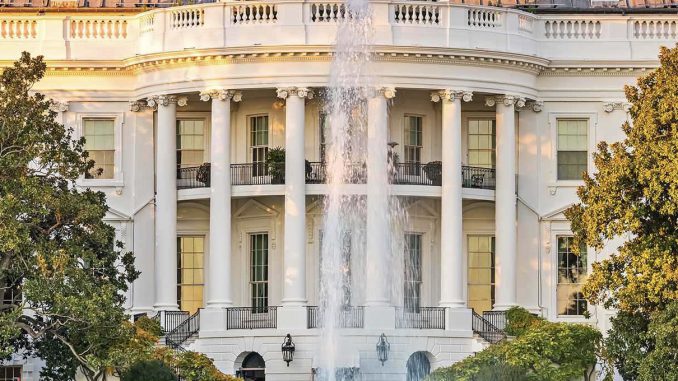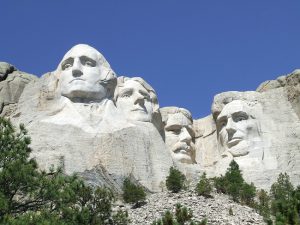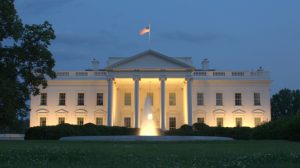
THE POWERS OF THE EXECUTIVE BRANCH
The executive exercises vital powers in foreign and domestic areas. He is principally responsible for the nation’s foreign policy: He negotiates treaties, receives ambassadors,and serves as commander in chief of the military. The President may appoint officers. He is responsible for executing, or carrying out, the laws of the land, but also has the discretion to pardon.
Though the Founders created a unitary executive, the legislature exercises several important checks on the executive, holding the power to declare war, advise and consent to appointments, and ratify treaties. As the only wholly national figure, the President reports to Congress on the State of the Union. The President may convene sessions of Congress and has a duty to provide recommendations for legislation.
Oath of Office — Article II, Section 1, Clause 8
Article II of the Constitution contains the Presidential Oath Clause. Under this clause, a new President must swear to be faithful to the office and do his best to preserve and protect the Constitution. The oath is typically administered by the Chief Justice.
Although Article VI of the Constitution requires federal officers to take oaths in support of the Constitution, the oath for Presidents was specifically included as an internal check to ensure a well-behaved, virtuous executive. Some scholars debate whether this oath limits or extends presidential powers.
The location and phrasing of the clause suggest that it is limiting insofar as it limits how the President’s executive power is to be exercised. Some scholars, however, think it gives the President extra power to interpret the Constitution and to act in protection of the country.
Take Care Clause — Article II, Section 3
The Take Care Clause, also known as the Faithful Execution Clause, sets out the main responsibility of the President: He must “take Care that the Laws be faithfully executed.” Based on the Pennsylvania and New York constitutions, the Take Care Clause makes the executive responsible for the enforcement of laws. In fact, George Washington understood this clause to mean he had a duty to execute federal law. This clause does not mean that the President is without discretion or that he is a mere overseer of the execution of laws. The President has broad discretion over how and when to enforce the law. The President may not take actions that are not authorized either by the Constitution or by a valid law.
The President’s discretion has led to controversy. For instance, one controversy regarding congressional appropriations. Presidents since Thomas Jefferson have been impounding funds or even refusing to use any money for particular programs. Opponents of the practice argue that the Take Care Clause reveals impounding to be unconstitutional. This practice is now rare, since the Supreme Court held that President Richard Nixon did not have broad authority to impound funds.
In the modern era, there are two significant challenges to the President’s responsibility to take care that the laws are executed: administrative agencies and the judiciary. Administrative agencies execute certain federal laws but are not accountable to the President. Judges have taken it upon themselves to determine whether laws have been executed properly, even when the person or group bringing the case before the court lacks standing (meaning that they have not suffered a wrong or harm). This behavior is problematic because the executive is responsible for executing the laws, while judges may address the application of the law only when there is a case of before them.
The President’s Role in Law-Making:
Presentment Clause and Pocket Veto Powers
Veto Powers of Article I, Section 7, Clause 2–3
The Presentment Clause, or Lawmaking Clause, outlines the exclusive method for the passage of federal statutes. One of the most formal and detailed clauses in the Constitution, the Presentment Clause involves both the legislative and executive branches in the law-making process: All federal bills must pass both houses of Congress and be subject to the President’s veto. The President has 10 days to review a bill and to approve or veto it. If the President vetoes the bill, he must return it to the chamber in which it originated, either the House of Representatives or the Senate.
Congress may override the veto if a two-thirds majority passes the bill in both houses. But what happens if the President refuses to approve the bill or to return it to Congress? What if the President vetoes the bill but Congress is not in session to receive it and therefore not able to override the veto? The Pocket Veto Clause addresses these issues. According to the Pocket Veto Clause, if Congress is adjourned, the bill will not become law. That is, if the President does not want to veto the bill in the traditional manner, he can simply hold on to it until Congress adjourns. The bill then “dies.”
Pardon Power — Article II, Section 2, Clause 1
The pardon power, as outlined in Article II, is one of the President’s most unregulated powers. The presidential power to pardon was derived from the Royal Prerogative of Kings. During the period under the Articles of Confederation, many state constitutions granted their governors power to pardon. In the Constitution, the President’s pardon power has two limitations: The offenses must be against the country (i.e., pardons could not excuse violations of state law alone), and they cannot be used in cases of impeachments (i.e., the President cannot pardon himself ).
The pardon power is subject to the President’s discretion. It is meant to reflect mercy as well as to carry out justice in the event of wrongful conviction. The pardon power also serves broader public-policy purposes. For instance, the President ensures peace and tranquility when using the power to defuse rebellions or other internal struggles.
Commissions — Article II, Section 3
In British tradition, the king created offices and granted commissions as he thought appropriate. Early Americans rejected this practice because they believed it consolidated too much power in the executive. Following Independence, the new state and national governments experimented with decentralized methods of appointing and commissioning officials. In crafting the Constitution, the Framers decided that the power to grant commissions was indeed an executive function and therefore vested in the President the power to “Commission all the Officers of the United States.”
The Appointment power begins with the creation of an office, generally done by Congress. The President nominates principal officers, and the Senate confirms them. Congress may by law vest the appointment of inferior officers in other persons or departments (but not in Congress itself ). Finally, the President commissions the chosen officers. The placement of the Commissions Clause is instructive. It is attached to the Take Care Clause rather than included in the discussion of appointments in Article II, Section 2. Though the executive power is vested in the Presidentalone, these clauses suggest that the President exercises this power through government officials, and the President is ultimately accountable for these officers and the decisions they make.
Commander in Chief — Article II, Section 2, Clause 1
Under Article II of the Constitution, the President is commander in chief of the armed forces. In early America, people gave their political leaders few powers in times of war. After seeing the failures of weak executive power under the Articles of Confederation and in state governments, the Framers opted for a single, energetic, decisive leader in times of war. The Framers, however, did not want an unchecked executive and therefore granted Congress certain powers, such as the power to declare war and control military resources, to check the executive. To put it another way, the executive held the “sword,” but the legislature held the “purse” (meaning responsibility for budget matters).
There is much debate on the extent of Congress’s authority to check the President’s commander in chief power. Two conflicting ideas, Congressionalists and Presidentialists. Both sides cite the text of the Constitution and the words of the Framers to support their positions. Congressionalists argue that the Declare War Clause and the Marque and Reprisal clause grant Congress broad power over wartime activities: specifically, that the President has no authority to initiate hostilities without prior approval from Congress. Presidentialists argue that Congress retains only power over funding and removing executive officers. They argue that the Executive Vesting clause together with the Commander in Chief Clause confer substantial power on the President to engage military forces in hostilities and draw a distinction between Congress’s power to “declare war” and the President’s ability to repel invasions of military force. The modern debate over the allocation of war powers between Congress and the President was triggered by the establishment of a large peace time military force after World War II.
Modern Congressionalists have tried to cement their position by passing the War Powers Resolution, which limits presidential ability to engage hostility and requires congressional consultation for military deployments. This act has proved ineffective, since Presidents enter various conflicts or use military force without congressional approval.
Commander of Militia — Article II, Section 2, Clause 1
Article II grants the President the power to be the commander in chief of the militia. Although the Framers agreed that there should be a national army, they still placed great importance on the militia. When the state militias were called into national service, the President would command them.
In 1792, Congress passed the Uniform Militia Act, which allowed the President to call out the militia to put down rebellions or insurrections. The militia assisted federal forces in several campaigns against American Indians in the Ohio Territory. In 1794, President George Washington issued the first formal call for the militia to put down a rebellion, the Whiskey Rebellion. In subsequent years, Presidents exercised control over the state militias. In 1795, Congress broadened the President’s ability to call forth and command the militia in times of insurrection and invasion, leading state governors to challenge the President’s power. The Supreme Court affirmed that the President’s power over the militia is coextensive with his power over the rest of the armed forces when the militia is engaged in national duties.
The militia system faded after the Civil War but returned with the 1916 National Defense Act as the National Guard. Although state governors have occasionally challenged the use of their states’ Guard units by the federal government, the President has maintained control. Since that time, National Guard members have served as draftees or reserves for the regular Army and have helped to suppress domestic uprisings.
Treaty Clause — Article II, Section 2, Clause 2
The Treaty Clause is one of the few clauses that divides an executive power between the President and Congress. According to this Article II clause, the President may make international treaties, but the supermajority of the Senate must ratify treaties in order for them to have the force of law.
The Framers saw treaties as involving a combination of foreign policy (the responsibility of the President) and law-making (the responsibility of Congress). Because treaties become the law of the land, they are not to be entered into or ratified without great care.
Some questions remain regarding the Treaty Clause. First, is the Treaty Clause the only way to enter international obligations? Second, how should the President and the Senate interact as they exercise their joint power? Third, who terminates a treaty: the President alone, Congress alone, or the President with consent of two-thirds of the Senate? Finally, what are the limits of the treaty power?
The modern practice of treaty-making largely conforms with the Framers’ vision. The President negotiates treaties, but there is often much consultation between the executive and the members of the Senate. The Senate sometimes approves the treaties with conditions.
The modern practice of executive agreements departs from the Framers’ vision in certain respects. Executive agreements covering matters within the President’s executive power and made pursuant to a treaty or to an Act of Congress seem to align with the Framers’ vision. But executive-congressional agreements that have the consent of the majority of both Houses of Congress and executive agreements made without the approval of Congress or the Senate are more problematic.
Ambassadors — Article II, Section 3
Article II of the Constitution gives the President the duty to receive ambassadors and other important ministers of foreign nations. Under the Articles of Confederation, Congress received ambassadors, but the Convention vested this power in the executive. Receiving ambassadors amounts to recognizing a nation’s government. Refusing to receive an ambassador amounts to a decision not to “recognize” a foreign government, or at least not to carry on diplomatic relations with it, which has particular implications in international law.
Whether the clause grants the President the unfettered ability to recognize another nation for diplomatic purposes has been the subject of much debate. In the Pacificus-Helvidius debates, James Madison (as “Helvidius”) argued that receiving ambassadors is a merely ministerial duty, but Alexander Hamilton (as “Pacificus”) argued that the clause gave the President the power to decide the obligations of the nation with regard to foreign nations. As a practical matter, Hamilton’s position won. Though Congress possesses other formal powers over foreign affairs, the President’s ability to receive ambassadors gives him considerable advantages in the conduct of foreign policy.
Appointments Clause — Article II, Section 2, Clause 2
The Appointments Clause of Article II sets out the rules for the appointment of constitutional officers. Officers are either principal or inferior officers, and each type has a different manner of appointment. The Appointments Clause applies to principal officers. An appointment consists of three distinct, sequential acts: The President nominates a candidate, the Senate confirms the nominee, and the President appoints the official.
The Framers designed the appointment process to ensure that the President would be accountable for the selection of officers and that his appointments would not be the result of secret deals.
The President has a plenary power to nominate. The power to nominate is an exclusive executive prerogative. Though the choice of officer is the President’s responsibility,the Senate’s advice and consent forestalls the possibility of abuse of the appointment power.
Congress has established qualifications for those who can serve as officers, but it is unclear how far these qualifications may go before they contravene the Framers’ intent in assuming the President’s accountability for the initial choice. The Senate has plenary authority to reject nominees, and nothing in the text limits what the Senate may consider when consenting to or rejecting a nominee. Thus, the Senate may use its advice and consent power to reject a nominee for unsound principles or blemished character. The President’s power of repeated nomination checks the Senate’s ability to reject a nominee without a compelling reason. The Senate’s consent, however, does not bind the President; the President has the power to choose not to appoint an official whom the Senate has confirmed.
Inferior Officers — Article II, Section 2, Clause 2

The Appointments Clause of Article II sets out the rules for the appointment of constitutional officers. Congress creates two types of officers under the Constitution: principal and inferior officers, each of which has a different manner of appointment. According to Douglas Cox, principal officers must be appointed by the President with the advice and consent of the Senate, but inferior officers (which is what most officers are) may be appointed by the President, courts, or heads of departments without the consent of the Senate. These two methods are the only means of appointing officers under the Constitution. Significantly, Congress may not vest the power to appoint in Congress itself. Congress’s role is limited to the Senate’s ability to offer advice and consent to nominees and to decide in which departments to vest the appointment power for a particular office.
The Framers designed this clause to prevent Congress from using the appointment power to fill offices with individuals who would be subservient to Congress, thereby limiting the power of the President to creating or filling offices arbitrarily. Scholars have noted ambiguities in the clause. For instance, what is the difference between principal and inferior officers besides the different mechanisms for appointments? Who are heads of departments? The courts have attempted to provide guidance on these questions by listing factors and duties that would fall on inferior rather than principal officers and by looking to the Opinion Clause to determine the meaning of “heads of departments.” In general, however, such designations are made on a case-by-case basis.
Recess Appointments Clause — Article II, Section 2, Clause 3
The Recess Appointments Clause is an extension of the President’s appointment power. It allows the President to use Recess Appointments to fill vacancies that occur while the Senate is in recess. Recess Appointments last until the end of the following Senate session, meaning that most recess appointments today may last one to two years.
Presidents have used this power to appoint officials during intersession recesses (the time period between two congresses) and intrasession recess (a recess of a current session of Congress). In early America, Senate recesses lasted six to nine months. The Recess Appointments Clause safeguarded the system by allowing appointments without requiring the Senate to stay in session perpetually. However, Presidents in modern times may use this power to select officers without having to face the senatorial confirmation process.
Communicating with Congress
State of the Union — Article II, Section 3
The Framers thought that the President would be uniquely qualified to summarize,explain, and assess information about the country. He would have unique knowledge of military operations, foreign affairs, and the execution of the laws and would be the only national representative of the entire people. Therefore, Article II of the Constitution gives the President the duty of periodically providing information to Congress about the “State of the Union”—a duty that encourages transparency and accountability in the executive branch. Other constitutionally defined communications with Congress include veto messages, advice and consent of the Senate, and recommendations. These communications are examples of the partial agency of one department in the working of another department.
Beginning with George Washington, early Presidents gave “Annual Messages” to the Senate, focusing on foreign affairs or reporting recommendations from department heads. In the 20th century, the State of the Union became less about reporting and assessing and more about advocating policies. With improvements in communication technology, the State of the Union now reaches a much wider audience via television, radio, the Internet, and other media.
Recommendations Clause — Article II, Section 3
The Recommendations Clause is another example of how the Framers divided powers among the branches of government. When presented with a bill from Congress, the President may sign it into law or veto it. Under the Recommendations Clause, though, the President may make recommendations to Congress for legislation.
The language of the clause underscores the republican nature of the process. These recommendations are not royal edicts, but suggestions to the people’s and the states’ representatives. The President’s recommendations provide a more national perspective, since his constituency differs from that of the House and Senate. Under this clause, the President alone may judge when it is “necessary and expedient” to make a recommendation. Congress may not compel the President to make particular recommendations. The legislature, though, will not hesitate to criticize a President who fails to propose legislation regularly. Furthermore, Congress does not have a duty to implement the President’s suggestions. It may be wise for Congress to pass legislation in accordance to the President’s suggestions because the President still holds the veto power, but there is no constitutional requirement to do so.
In practice, early Presidents spent little time trying to influence Congress, except in times of war. Twentieth century Presidents, though, have departed from this tradition. Most notably, Franklin D. Roosevelt took an active role in shaping Congress’s legislative agenda by recommending new laws.
Convening of Congress — Article II, Section 3
In the Declaration of Independence, the Americans objected to the traditional British
policy that allowed the king to convene and adjourn Parliament at will. In Article
I, the Framers gave Congress the power to convene. Recognizing that emergencies
may arise when Congress is adjourned, the Convening of Congress Clause of Article
II gives the President a limited power to convene Congress on “extraordinary Occasions.”
Presidents rarely call special sessions, except to address emergencies such as
military conflicts and economic crises. Presidents may also adjourn Congress, but
only when Congress disagrees on its own time of adjournment.
In practice, the President has exercised this power only a few times in American history,
to address crises such as war or economic emergencies. In the later 20th century
and the 21st century, because Congress is functionally in session year-round,
the President’s power to convene is little used.
Editor’s Note:
Clay Blanche is a guest author for The Founding Project, who hopes to contribute regularly. Please check Clay’s Facebook page, “The Conservative Minuteman”, and join/like his page. https://www.facebook.com/conservativeminuteman/
https://www.americanbar.org/publications/insights_on_law_andsociety/17/fall-2016/how-presidents-interpret-the-constitution.html



Leave a Reply